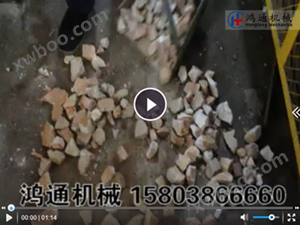Introduction to rock crusher:

Rock crusher, also known as double roll crusher. Mainly used for crushing ores. This machine has the advantages of small size, high crushing ratio (5-8), low noise, simple structure, easy maintenance, uniform particle size of crushed materials, low over crushing rate, easy maintenance, sensitive overload protection, safety and reliability. Rock crushers are suitable for industries such as coal, metallurgy, mining, chemical, and building materials, and are more suitable for crushing raw coal (including gangue) in large coal mines or coal preparation plants. Rock crushers (roller crushers) can be divided into double toothed roller crushers according to the different types of rollers. The double toothed roller crusher has a large crushing capacity, and the motor and reducer are connected by a limited distance hydraulic coupling to prevent power overload. The sensor overload protection ensures safety and reliability. Hydraulic adjustment of tooth roller spacing, centralized lubrication of tooth roller bearings. Tooth shape optimization design, selection of crushing for tensile and shear forces, high efficiency and low consumption, uniform particle output.
Image of rock crusher

Belt driven spring roller crusher
1210 Large Coupling Spring Roll Crusher Picture (View more pictures)
Continuous transmission hydraulic roller crusher
Rock crusher video——Click to view more videos of roller crushers
 |
 |
|
Marble crushing test machine video - Roll crusher |
Quartz stone crushing test machine video - roller crusher |
 |
 |
|
Shanxi aluminum magnesium alloy crushing test machine video _ Roll crusher |
Potassium feldspar crushing test machine video _ Roll crusher |
Shipping picture of rock crusher(Click to view more shipping pictures of roller crushers)
 |
 |
|
Delivery site of 1200 × 1000 rock crusher in Yibin, Sichuan |
Hubei Zhang 1200x1000 Rock Crusher Delivery Site |
 |
 |
|
Large 1210 rock crusher shipping picture |
400X400 rock crusher sent to Jinzhou, Liaoning |
Suitable materials for rock crusher:
 |
 |
 |
 |
River pebbles |
Calcite |
Quartz stone |
Marble |
 |
 |
 |
 |
Pebble stones |
Bentonite |
Rock |
Limestone |
River pebbles, calcite, quartz, marble, pebbles, bentonite, iron ore, bluestone, mountain stones, water slag, limestone, weathered sand, diabase, granite, basalt, etc.
Working principle of rock crusher:


Working principle diagram of double toothed roller crusher
1. This series of rock crushers (roller crushers) mainly consists of rollers, roller support bearings, clamping and adjusting devices, and driving devices.
2. Adjustment of discharge particle size: A wedge-shaped or shim adjustment device is installed between the two rollers, and the top of the wedge-shaped device is equipped with an adjustment bolt. When the adjustment bolt pulls up the wedge block, the wedge block pushes the movable roller wheel away from the fixed wheel, that is, the gap between the two rollers increases, and the discharge particle size increases. When the wedge block is lowered, the gap between the two rollers of the movable roller wheel decreases under the action of the compression spring, and the discharge particle size decreases. The gasket device adjusts the particle size of the discharge by increasing or decreasing the number or thickness of gaskets. When adding gaskets, the gap between the two rollers increases, and when reducing gaskets, the gap between the two rollers decreases, resulting in a smaller discharge particle size.
3. The driving mechanism is composed of two electric motors, which are transmitted to the pulley through a V-belt to drag the rollers and rotate them in opposite directions. When crushing materials, the materials are crushed through rollers from the feeding port, and the crushed products are discharged from under the chassis.
4. For safety reasons, the transmission part should be equipped with a safety cover according to the actual situation.
Technical parameters of rock crusher:
Specification and model |
Feed particle size |
|
(mm) |
Production capacity |
|
|
(kw) |
Weight |
(t) |
1.3 |
External dimensions |
||
Length, width, and height (mm) |
2PG400×250 |
<35<> |
2.3 |
≤2-8 |
||
2-10 |
2×5.5 |
3.9 |
2150×980×800 |
|||
2PG400×400 |
<35<> |
≤2-8 |
9.5 |
|||
5-12 |
2×7.5 |
2360×1100×800 |
10.8 |
|||
2PG610×400 |
<65<> |
≤2-20 |
14.9 |
5-20 |
||
2×15 |
3510×1420×1030 |
25.5 |
2PG750×500 |
|||
<75<> |
≤2-25 |
10-40 |
33.7 |
|||
2×18.5 |
4210×1630×1260 |
2PG800×600 |
41.2 |
<80<> |
≤2-25
12-45
2×22
4505×1780×1320
2PG1000×700
<100<>
≤3-30
20-65

2×30
5310×2175×1595

2PG1200×800<120<>≤3-3535-802×37
2PG1500×800
- <130<>
- ≤3-45
- 50-120
- 2×75
- 7460×2410×2290
2PG1600×1000
<150<>
-

-
≤3-50
-

-
60-140
-

-
2×90


